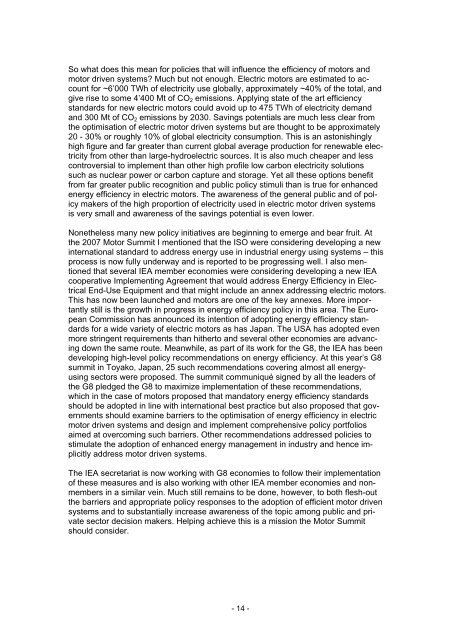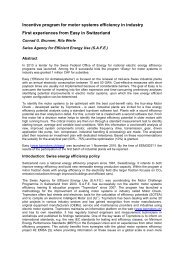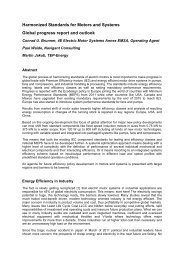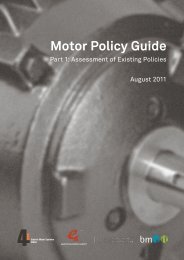MOTOR SUMMIT 08 - IEA 4E - Electric Motor Systems Annex
MOTOR SUMMIT 08 - IEA 4E - Electric Motor Systems Annex
MOTOR SUMMIT 08 - IEA 4E - Electric Motor Systems Annex
Create successful ePaper yourself
Turn your PDF publications into a flip-book with our unique Google optimized e-Paper software.
So what does this mean for policies that will influence the efficiency of motors and<br />
motor driven systems? Much but not enough. <strong>Electric</strong> motors are estimated to account<br />
for ~6’000 TWh of electricity use globally, approximately ~40% of the total, and<br />
give rise to some 4’400 Mt of CO2 emissions. Applying state of the art efficiency<br />
standards for new electric motors could avoid up to 475 TWh of electricity demand<br />
and 300 Mt of CO2 emissions by 2030. Savings potentials are much less clear from<br />
the optimisation of electric motor driven systems but are thought to be approximately<br />
20 - 30% or roughly 10% of global electricity consumption. This is an astonishingly<br />
high figure and far greater than current global average production for renewable electricity<br />
from other than large-hydroelectric sources. It is also much cheaper and less<br />
controversial to implement than other high profile low carbon electricity solutions<br />
such as nuclear power or carbon capture and storage. Yet all these options benefit<br />
from far greater public recognition and public policy stimuli than is true for enhanced<br />
energy efficiency in electric motors. The awareness of the general public and of policy<br />
makers of the high proportion of electricity used in electric motor driven systems<br />
is very small and awareness of the savings potential is even lower.<br />
Nonetheless many new policy initiatives are beginning to emerge and bear fruit. At<br />
the 2007 <strong>Motor</strong> Summit I mentioned that the ISO were considering developing a new<br />
international standard to address energy use in industrial energy using systems – this<br />
process is now fully underway and is reported to be progressing well. I also mentioned<br />
that several <strong>IEA</strong> member economies were considering developing a new <strong>IEA</strong><br />
cooperative Implementing Agreement that would address Energy Efficiency in <strong>Electric</strong>al<br />
End-Use Equipment and that might include an annex addressing electric motors.<br />
This has now been launched and motors are one of the key annexes. More importantly<br />
still is the growth in progress in energy efficiency policy in this area. The European<br />
Commission has announced its intention of adopting energy efficiency standards<br />
for a wide variety of electric motors as has Japan. The USA has adopted even<br />
more stringent requirements than hitherto and several other economies are advancing<br />
down the same route. Meanwhile, as part of its work for the G8, the <strong>IEA</strong> has been<br />
developing high-level policy recommendations on energy efficiency. At this year’s G8<br />
summit in Toyako, Japan, 25 such recommendations covering almost all energyusing<br />
sectors were proposed. The summit communiqué signed by all the leaders of<br />
the G8 pledged the G8 to maximize implementation of these recommendations,<br />
which in the case of motors proposed that mandatory energy efficiency standards<br />
should be adopted in line with international best practice but also proposed that governments<br />
should examine barriers to the optimisation of energy efficiency in electric<br />
motor driven systems and design and implement comprehensive policy portfolios<br />
aimed at overcoming such barriers. Other recommendations addressed policies to<br />
stimulate the adoption of enhanced energy management in industry and hence implicitly<br />
address motor driven systems.<br />
The <strong>IEA</strong> secretariat is now working with G8 economies to follow their implementation<br />
of these measures and is also working with other <strong>IEA</strong> member economies and nonmembers<br />
in a similar vein. Much still remains to be done, however, to both flesh-out<br />
the barriers and appropriate policy responses to the adoption of efficient motor driven<br />
systems and to substantially increase awareness of the topic among public and private<br />
sector decision makers. Helping achieve this is a mission the <strong>Motor</strong> Summit<br />
should consider.<br />
- 14 -





